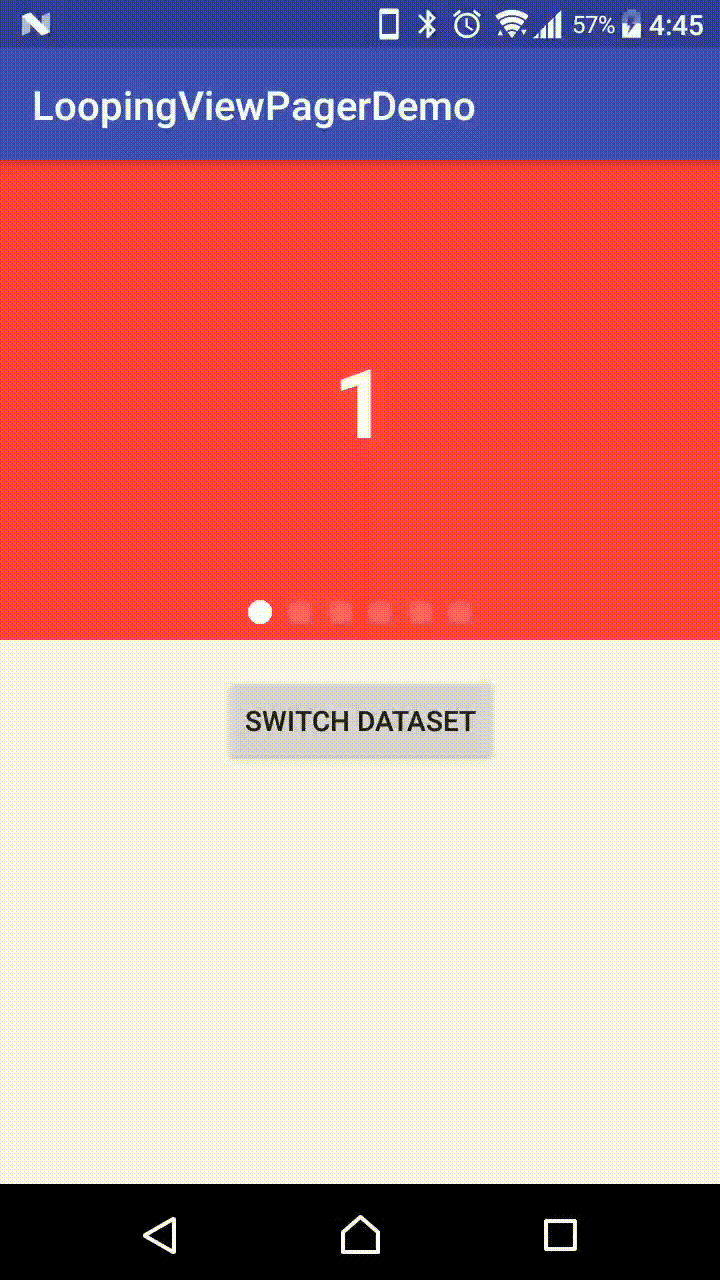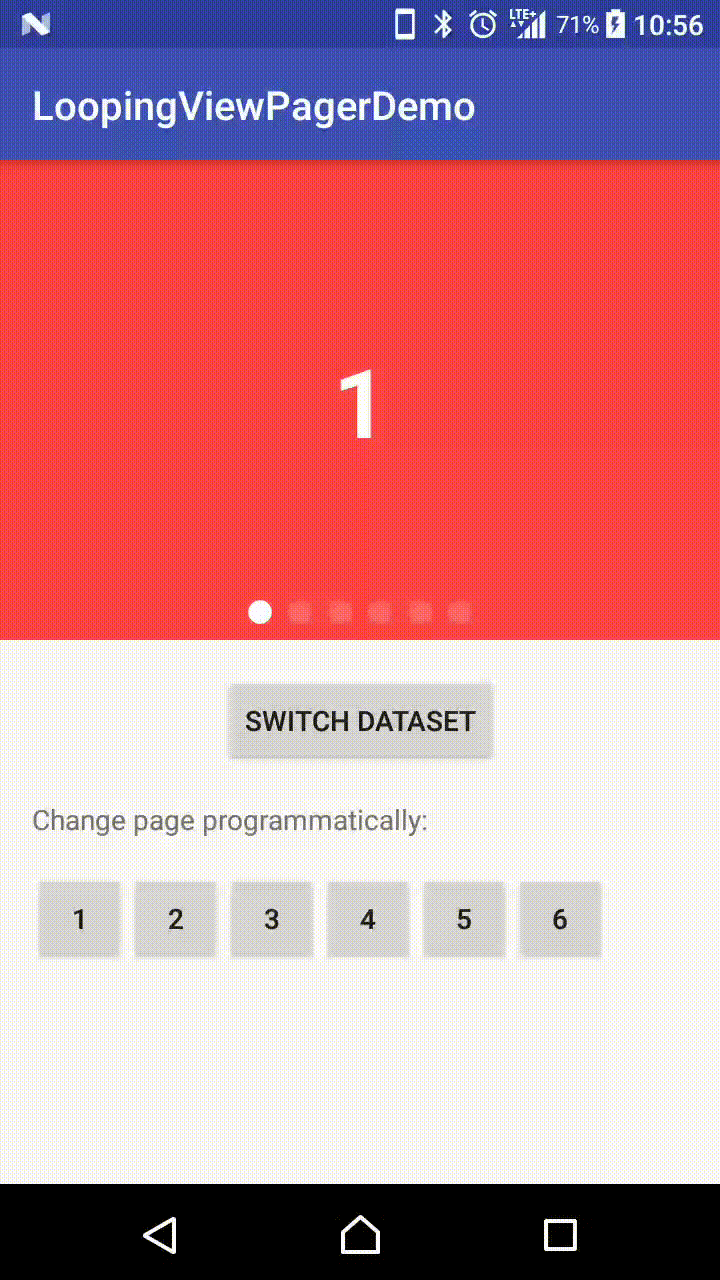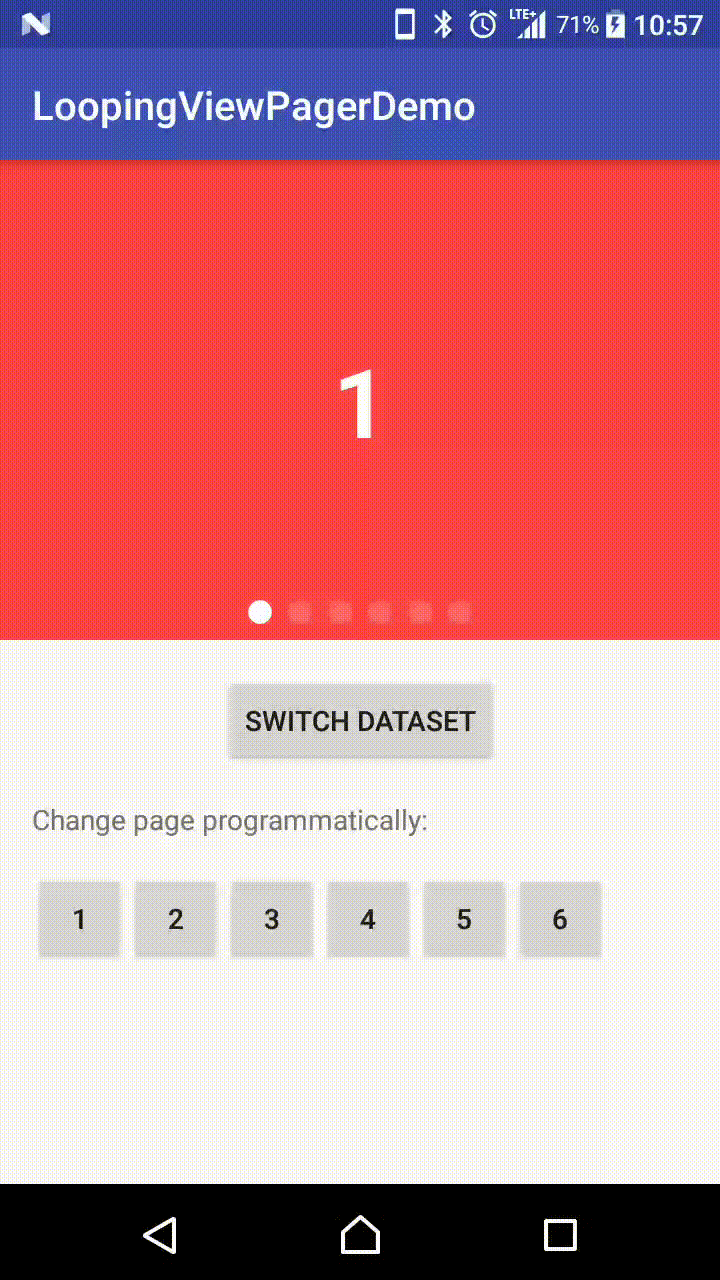I think I am not maintaining version 1.x.x anymore, and if I have time and interested in the future, I might re-write it using Compose.
With that said, I do think v1.4.1 is stable enough to use with ViewPager (Not ViewPager2). In case it is having issue with new versions of Kotlin / Android libraries, I wish you can folk it and use it with simple fixes. Thank you!
A ViewPager and a PagerAdapter that can:
- AutoScroll (On/Off able)
- Infinite Loop (On/Off able)
- Adjustable auto scroll interval
- Won't scroll nor loop if there is only 1 item
- Works well with notifyDataSetChanged()
- Supports page indicators
- Supports different view types
- Support peeking adjacent items (But first and last item will appear only after scroll state is idle)
Although there are already quite a number of similar libraries out there,
I cannot find one that fits all of the below requirements:
- Sufficient documentation
- Last updated in less than 3 years
- Good infinite looping effect
- Configurable auto-scroll
- Good support with Page Indicators
Especially for 5, even some of them supports, they provide built-in indicators only; or does not tell user how to implement their own indicator.
I wrote this library to tackle all of these problems I faced after trying a whole day with other libraries.
First make sure mavenCentral() is included as a repository in your project's build.gradle:
allprojects {
repositories {
mavenCentral()
}
}And then add the below to your app's build.gradle:
implementation 'com.asksira.android:loopingviewpager:1.4.1' <com.asksira.loopingviewpager.LoopingViewPager
android:id="@+id/viewpager"
android:layout_width="0dp"
android:layout_height="0dp"
app:isInfinite="true"
app:autoScroll="true"
app:scrollInterval="5000"
app:layout_constraintDimensionRatio="1.78"/>(The above xml example is placed inside a ConstraintLayout.)
| Attribute Name | Default | Allowed Values |
|---|---|---|
| isInfinite | false | true / false |
| autoScroll | false | true / false |
| scrollInterval | 5000 | any integer (represents ms) |
Please note that the height of LoopingViewPager should be decided by its parent, like all other Views.
If you want it to have a specific aspect ratio, you can place it inside a ConstraintLayout and give it the attribute layout_constraintDimensionRatio.
(The old versions of this library uses an internal attribute to determine its height, which is completely wrong and can lead to bugs!)
Note: If you want the ViewPager to be able to peek adjacent items, make use of clipToPadding=false and set padding to the ViewPager. (itemAspectRatio has been removed in v1.4.1)
You should
- Specify the data type in the generic (
<DataType>) - Create your own constructor according to this
DataType - override
inflateView()andbindView() - DO NOT override getCount(). Look at
LoopingPagerAdapter. getCount() has special implementation.
class DemoInfiniteAdapter(
itemList: ArrayList<YourObject>,
isInfinite: Boolean
) : LoopingPagerAdapter<YourObject>(itemList, isInfinite) {
//This method will be triggered if the item View has not been inflated before.
override fun inflateView(
viewType: Int,
container: ViewGroup,
listPosition: Int
): View {
return LayoutInflater.from(container.context).inflate(R.layout.item_pager, container, false)
}
//Bind your data with your item View here.
//Below is just an example in the demo app.
//You can assume convertView will not be null here.
//You may also consider using a ViewHolder pattern.
override fun bindView(
convertView: View,
listPosition: Int,
viewType: Int
) {
convertView.findViewById<View>(R.id.image).setBackgroundColor(convertView.context.resources.getColor(getBackgroundColor(listPosition)))
val description = convertView.findViewById<TextView>(R.id.description)
description.text = itemList?.get(listPosition).toString()
}
} adapter = DemoInfiniteAdapter(dataItems, true)
loopingViewPager.setAdapter(adapter) override fun onResume() {
super.onResume()
loopingViewPager.resumeAutoScroll()
}
override fun onPause() {
loopingViewPager.pauseAutoScroll()
super.onPause()
}If you have new data to update to your adapter, simply call:
adapter.setItemList(newItemList)
viewPager.reset() //In order to reset the current page positionSimple! Override one more method in your Adapter:
override fun getItemViewType(listPosition: Int): Int {
return if (itemList?.get(listPosition) == 0) VIEW_TYPE_SPECIAL else VIEW_TYPE_NORMAL
}And then, of course, according to the viewtype parameter passed to you in inflateView() and bindView(), differentiate what you need to inflate or bind.
You may also refer to the demo app for a complete example.
I don't officially provide a built-in page indicator because:
- ViewPager and Indicator are logically separated
- I want to make this library adaptable to all page indicators
With that said, I have created a simple CustomShapePagerIndicator included in this library.
It is simple but very flexible, because you need to / you can provide your own implementation of how to inflate the unselected and selected indicators.
I assume for any indicator libraries you use, they should provide a method for you to call so that you can simply redirect onPageScrolled(position: Int, positionOffset: Float, positionOffsetPixels: Int) of ViewPager.OnPageChangeListener to the indicator library,
And then the indicator library will then be able to handle the transitions for you, which is also the case in CustomShapePagerIndicator.
So, the job of LoopingViewPager is simply to mask the infinite behavior into a onPageScrolled behavior which looks like it is not infinite.
In other words, when you scroll from last page to first page, it will be converted to directing jumping from last page back to first page;
When you scroll from first page backward to last page, it will be converted to directing jumping from first page to last page.
If you do not accept this assumption, I am sorry but you probably need to find something else.
So, instead of adding another onPageChangeListener, you simply do this:
(Below example is using built in CustomShapePagerIndicator)
loopingViewPager.onIndicatorProgress = { selectingPosition, progress ->
indicatorView.onPageScrolled(selectingPosition, progress)
}Note that this is a brand new implementation of how LoopingViewPager in v1.3.0, after I realized how wrong I was 2 years ago.
If you need to stick with the old implementation, please use v1.2.0 and checkout the README.md at the commit before this version.
(You can always refer to the demo app.)
First, add CustomShapePagerIndicator to your XML, use wrap_content for width and height,
And specify the spacing between unselected indicators (app:indicator_spacing="?dp"):
<com.asksira.android.customshapepagerindicator.CustomShapePagerIndicator
android:id="@+id/indicator"
android:layout_width="wrap_content"
android:layout_height="wrap_content"
app:layout_constraintBottom_toBottomOf="@id/viewpager"
app:layout_constraintLeft_toLeftOf="parent"
app:layout_constraintRight_toRightOf="parent"
android:layout_marginBottom="8dp"
app:indicator_spacing="4dp"/>Then, tell the indicator how to inflate your unselected of highlighter indicators:
customShapePagerIndicator.highlighterViewDelegate = {
val highlighter = View(this)
highlighter.layoutParams = FrameLayout.LayoutParams(16.dp(), 2.dp())
highlighter.setBackgroundColor(getColorCompat(R.color.white))
highlighter
}
customShapePagerIndicator.unselectedViewDelegate = {
val unselected = View(this)
unselected.layoutParams = LinearLayout.LayoutParams(16.dp(), 2.dp())
unselected.setBackgroundColor(getColorCompat(R.color.white))
unselected.alpha = 0.4f
unselected
}Note that you must provide a fixed width and height for your indicators.
Because CustomShapePagerIndicator use margins internally to handle indicator spacing, please do not specify your own margin when providing your own views.
Finally, for the first time and whenever you need to update your indicator counts:
customShapePagerIndicator.updateIndicatorCounts(loopingViewPager.indicatorCount)v1.4.1
- Removed setting aspect ratio inside LoopingViewPager. Let its parent to decide how to layout it (i.e. its height).
- Same as above, removed itemAspectRatio as well. You can actually simply set it through padding and
clipToPadding=false. - Removed unnecessary context as a param in LoopingPagerAdapter's constructor.
- Migrated from JCenter() to MavenCentral().
v1.3.2
- Fixed crash due to getChildAt() returns null
v1.3.1
- Converted everything to Kotlin
- Revamp the whole logic of pager indicator handling
- Added built-in
CustomShapePagerIndicator
v.1.2.0
- Added requirement mentioned in #17.
v1.1.4
- Merged #11.
v1.1.3
- Merged #15 which includes AndroidX support and
resetAutoScroll()which is equivalent topauseAutoScroll()and thenresumeAutoScroll().
v1.1.2
- Added
ViewGroup containeras an argument toinflateView(). You should now use it as the parent of when you inflate your view. - Updated gradle version and support library version.
v1.1.0
- Added support for view type. But therefore changed parameters needed in
inflateView()andbindView().
v1.0.5
- Added asepct ratio attribute for
LoopingViewPager - Rewrote the way of caching Views in
LoopingPagerAdapter, and therefore separated inflation and data binding - Rewrote the way of implementing ViewPager wrap_content
v1.0.4
- Indicator now works with page skipping as well (By calling
selectCurrentItem()) - Leviated indicator fluctuating phenomenon when using
onIndicatorProgress()callback - Added option for smart or non-smart indicators
v1.0.1
- Fixed a bug where getSelectingIndicatorPosition() is returning incorrect value.
- Updated README.md according to PageIndicatorView v1.0.0 update.
Copyright 2017 Sira Lam
Permission is hereby granted, free of charge, to any person obtaining a copy of this software and
associated documentation files (the LoopingViewPager), to deal in the Software without restriction,
including without limitation the rights to use, copy, modify, merge, publish, distribute, sublicense,
and/or sell copies of the Software, and to permit persons to whom the Software is furnished to do so,
subject to the following conditions:
The above copyright notice and this permission notice shall be included in all copies or
substantial portions of the Software.
THE SOFTWARE IS PROVIDED "AS IS", WITHOUT WARRANTY OF ANY KIND, EXPRESS OR IMPLIED,
INCLUDING BUT NOT LIMITED TO THE WARRANTIES OF MERCHANTABILITY, FITNESS FOR A PARTICULAR PURPOSE
AND NONINFRINGEMENT. IN NO EVENT SHALL THE AUTHORS OR COPYRIGHT HOLDERS BE LIABLE FOR ANY CLAIM,
DAMAGES OR OTHER LIABILITY, WHETHER IN AN ACTION OF CONTRACT, TORT OR OTHERWISE, ARISING FROM,
OUT OF OR IN CONNECTION WITH THE SOFTWARE OR THE USE OR OTHER DEALINGS IN THE SOFTWARE.


